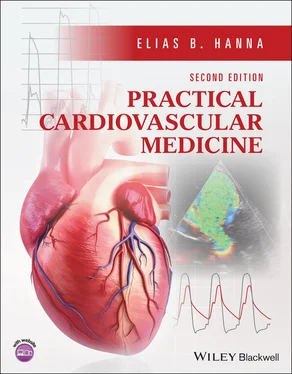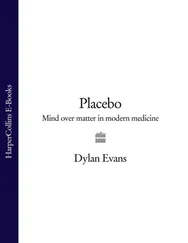13 Part 6: PERICARDIAL DISORDERS 17 Pericardial Disorders 1. ACUTE PERICARDITIS 2. TAMPONADE 3. PERICARDIAL EFFUSION 4. CONSTRICTIVE PERICARDITIS QUESTIONS AND ANSWERS References Further reading
14 Part 7: CONGENITAL HEART DISEASE Chapter 18: Congenital Heart Disease 1. ACYANOTIC CONGENITAL HEART DISEASE 2. CYANOTIC CONGENITAL HEART DISEASE 3. MORE COMPLEX CYANOTIC CONGENITAL HEART DISEASE AND SHUNT PROCEDURES QUESTIONS AND ANSWERS References
15 Part 8: PERIPHERAL ARTERIAL DISEASE 19 Peripheral Arterial Disease 1. LOWER EXTREMITY PERIPHERAL ARTERIAL DISEASE I. Clinical tips II. Clinical classification of PAD – Critical limb ischemia, acute limb ischemia, atheroembolization III. Diagnosis of PAD IV. Medical therapy of PAD V. Revascularization for PAD VI. Notes on the technical aspects of surgical and percutaneous therapies VII. Management of acute limb ischemia VIII. Management of lower extremity ulcers (Table 19.6) 2. CAROTID DISEASE I. Assessment of carotid stenosis II. Medical therapy of carotid stenosis III. Revascularization of asymptomatic carotid stenosis IV. Revascularization of symptomatic carotid stenosis V. Main risks of CEA and carotid stenting VI. CEA versus carotid stenting VII. Carotid disease in a patient undergoing CABG VIII. Subtotal and total carotid occlusions 3. RENAL ARTERY STENOSISI. Forms of renal artery stenosis II. Screening and indications to revascularize renal artery stenosis III. Notes QUESTIONS AND ANSWERS References 20 Aortic Diseases I. Aortic dissection II. Thoracic aortic aneurysm III. Abdominal aortic aneurysm References
16 Part 9: OTHER CARDIOVASCULAR DISEASE STATES 21 Pulmonary Embolism and Deep Vein Thrombosis 1. PULMONARY EMBOLISMI. Presentation of pulmonary embolism (PE) and risk factors II. Probability of PE III. Initial workup IV. Specific PE workup V. Submassive or intermediate-high risk PE, pulmonary hypertension, and thrombolysis VI. PE and chronic pulmonary hypertension VII. Acute treatment of PE VIII. Duration of anticoagulation IX. Thrombophilias X. PE prognosis and long-term follow-up 2. DEEP VEIN THROMBOSISI. Types II. Diagnosis III. Treatment 3. IMMUNE HEPARIN-INDUCED THROMBOCYTOPENIA I. Incidence II. Diagnosis III. Treatment QUESTIONS AND ANSWERS References 22 Shock and Fluid Responsiveness 1. SHOCK I. Shock definition and mechanisms II. Goals of shock treatment III. Immediate management of any shockIV. Sepsis and septic shock V. Cardiogenic shock 2. FLUID RESPONSIVENESS Appendix. Hemodynamic equations, transfusion, and miscellaneous concepts QUESTIONS AND ANSWERS References Note 23 Hypertension 1. HYPERTENSIONI. Definition II. ACC and ESC targets of therapy and rationale III. Treatment of hypertension: timing, first-line drugs, compelling indications for specific drugs IV. Resistant hypertension V. Secondary hypertension VI. Peripheral vs. central aortic pressure: therapeutic implications VII. First-line antihypertensive drugs VIII. Second-line antihypertensive drugs IX. Orthostatic hypotension and extremely labile HTN 2. ACUTE SEVERE HYPERTENSION: HYPERTENSIVE EMERGENCIES AND URGENCIESI. Definitions II. Treatment of hypertensive emergencies III. Treatment of hypertensive urgencies IV. Specific situations (see Table 23.5) QUESTIONS AND ANSWERS References 24 Dyslipidemia I. Indications for therapy II. Notes on LDL, HDL, and triglycerides III. Drugs: LDL-lowering drugs IV. Drugs: TG/HDL-treating drugs and lifestyle modification V. Metabolic syndrome VI. Diabetes and cardioprotective diabetic drugs VII. Elevated hs-CRP (high-sensitivity C-reactive protein test) ≥2 mg/l VIII. Chronic kidney disease (CKD) IX. Causes of dyslipidemia to consider X. Side effects of specific drugs: muscle and liver intolerance with statins, fibrates, and niacin XI. Aspirin is ineffective in primary prevention QUESTIONS AND ANSWERS References 25 Pulmonary Hypertension I. Definition II. Categories of PH III. Two tips in the evaluation of PH IV. Hypoxemia in patients with PH V. Diagnosis: echocardiography; right and left heart catheterization VI. Treatment QUESTIONS AND ANSWERS References 26 Syncope I. Neurally mediated syncope (reflex syncope) II. Orthostatic hypotension and postural orthostatic tachycardia syndrome III. Cardiac syncope IV. Other causes of syncope V. Syncope mimic: seizure (see Table 26.1) VI. Clinical clues (see Table 26.2) VII. Diagnostic evaluation of syncope ( Figure 26.1 ) VIII. Tilt table testing (see Table 26.4) 10, 40 IX. Indications for hospitalization X. Treatment of vasovagal syncope, orthostatic hypotension, and POTS QUESTIONS AND ANSWERS References 27 Chest Pain, Dyspnea, Palpitations 1. CHEST PAINI. Causes (see Table 27.1) II. Features III. Management of chronic chest pain IV. Management of acute chest pain 2. ACUTE DYSPNEAI. Causes (see Table 27.2) II. Notes III. Management 3. PALPITATIONSI. Causes II. Diagnosis References 28 Infective Endocarditis and Cardiac Rhythm Device Infections 1. INFECTIVE ENDOCARDITISI. Clinical diagnosis II. Echocardiography: timing and indications III. Organisms IV. Morphology V. Anatomical complications VI. Indications for valvular surgery and special situations 2. CARDIAC RHYTHM DEVICE INFECTIONSI. Organisms and mechanisms of infection II. Diagnosis III. Diagnosis in patients with bacteremia but no local or TEE signs of infection IV. Management References 29 Preoperative Cardiac Evaluation I. Steps in preoperative evaluation II. Surgical risk: surgery’s risk and patient’s risk III. CARP and DECREASE V trials IV. Only the highest-risk coronary patients require revascularization preoperatively V. Preoperative percutaneous revascularization VI. Surgery that needs to be performed soon after stent placement VII. Preoperative β-blocker therapy VIII. Other interventions that improve outcomes IX. Severe valvular disease X. Perioperative hypertension XI. Preoperative management of patients with pacemakers or ICDs QUESTIONS AND ANSWERS References 30 Miscellaneous Cardiac Topics 1. CARDIAC MASSESI. Differential diagnosis of a cardiac mass II. Cardiac tumors; focus on atrial myxoma 2. PREGNANCY AND HEART DISEASE I. High-risk cardiac conditions during which pregnancy is better avoided 9 II. Cardiac conditions that are usually well tolerated during pregnancy, but in which careful cardiac evaluation and clinical and echo follow-up are warranted 9 III. Cardiac indications for cesarean section IV. Mechanical prosthetic valves in pregnancy: anticoagulation management V. Peripartum cardiomyopathy (PPCM) VI. Cardiovascular drugs during pregnancy (see Table 30.2) VII. Arrhythmias during pregnancy VIII. MI and pregnancy IX. Hypertension and pregnancy 3. HIV AND HEART DISEASEI. Pericardial disease II. HIV cardiomyopathy III. Pulmonary hypertension (PH) IV. CAD 4. COCAINE AND THE HEARTI. Myocardial ischemia II. Other cardiac complications of cocaine 5. CHEMOTHERAPY AND HEART DISEASEI. Cardiomyopathy II. Myocardial ischemia III. Atrial fibrillation 6. CHEST X-RAYI. Chest X-ray in heart failure (see Figures 30.2, 30.3) II. Various forms of cardiomegaly (see Figure 30.4) III. Left atrial enlargement; aortic dilatation IV. Lateral chest X-ray V. Chest X-ray in congenital heart disease QUESTIONS AND ANSWERS References
17 Part 10: CARDIAC TESTS: ELECTROCARDIOGRAPHY, ECHOCARDIOGRAPHY, AND STRESS TESTING 31 Electrocardiography I. Overview of ECG leads and QRS morphology II. Stepwise approach to ECG interpretation III. Rhythm and rate IV. QRS axis in the limb leads and normal QRS progression in the precordial leads V. P wave: analyze P wave in leads II and V 1for atrial enlargement, and analyze PR interval (see Figures 31.18, 31.19) VI. Height of QRS: LVH, RVH VII. Width of QRS. Conduction abnormalities: bundle brunch blocks VIII. Conduction abnormalities: fascicular blocks IX. Low QRS voltage and electrical alternans X. Assessment of ischemia and infarction: Q waves XI. Assessment of ischemia: ST-segment depression and T-wave inversion XII. Assessment of ischemia: differential diagnosis of ST-segment elevation XIII. Assessment of ischemia: large or tall T wave XIV. QT analysis and U wave XV. Electrolyte abnormalities, digitalis effect and digitalis toxicity, hypothermia, PE, poor precordial R-wave progression XVI. Approach to tachyarrhythmias XVII. Approach to bradyarrhythmias: AV block XVIII. Abnormal automatic rhythms that are not tachycardic XIX. Electrode misplacement Appendix 1. Supplement on STEMI and Q‐wave MI: phases and localization Appendix 2. Spread of electrical depolarization in various disease states using vector illustration ( Figures 31.100 – 31.103 ) QUESTIONS AND ANSWERS References Further reading 32 Echocardiography 1. GENERAL ECHOCARDIOGRAPHYI. The five major echocardiographic views and the myocardial wall segments II. Global echo assessment of cardiac function and structure III. Doppler and assessment of valvular regurgitation and stenosis IV. Summary of features characterizing severe valvular regurgitation and stenosis (see Tables 32.1, 32.2) V. M-mode echocardiography VI. Pericardial effusion VII. Echocardiographic determination of LV filling pressure and diastolic function VIII. Additional echocardiographic hemodynamics IX. Prosthetic valves X. Brief note on Doppler physics and echo artifacts 2. TRANSESOPHAGEAL ECHOCARDIOGRAPHY (TEE) VIEWS Appendix. Note on LV mechanics and myocardial tissue strain Further reading 33 Stress Testing, Nuclear Imaging, Coronary CT Angiography, Cardiac MRI, Cardiopulmonary Exercise Testing I. Indications for stress testing II. Contraindications to all stress testing modalities III. Stress testing modalities IV. Diagnostic yields and pitfalls of stress ECG and stress imaging V. Mechanisms of various stress modalities VI. Nuclear stress imaging (see Figures 33.3, 33.4, 33.5) VII. Coronary CT angiography and coronary calcium scoring VIII.Cardiac MRI: summary of applications and findings IX.Cardiopulmonary exercise testing (CPET) References
Читать дальше












